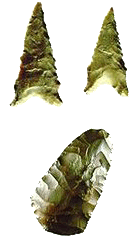|
The Dalton Culture: End of Ice Age Transitions
8500-8000 B.C. by George Sabo III
With the warmer climate and seasonally changing weather patterns, temperate hardwood and hardwood/pine forests expanded in the mid-South. Tundra and boreal forests disappeared. Rivers and streams carrying cold water from melting glaciers slowed down and warmed up, providing habitats suitable for many aquatic species. These environmental changes meant increased availability of many resources: nuts, fruits, and seeds; fish, shellfish, and waterfowl; and forest-dwelling animals. In response, Dalton communities organized their food-getting strategies around the seasonal availability of different kinds of foods. The number of Dalton sites recognized by archeologists indicates an increase in population to perhaps five hundred or more people across the state. Excavations at intact Dalton sites in Arkansas demonstrate that people occupied multi-season base camps for extended periods—perhaps for several years at a time—from which they traveled to other nearby localities to hunt, fish, collect nuts and other plant foods, and acquire chert (a kind of flint that occurs in limestone bedrock) or other materials for the manufacture of weapons and other implements. The Brand site, located in northeastern Arkansas and excavated in the 1970s by Albert Goodyear, is a Dalton hunting camp where people refurbished their tool kits and butchered deer and other animals taken in the chase. Perhaps the most interesting Dalton site is the Sloan site, also located in northeastern Arkansas, on the summit of a low sand dune in the Cache River valley. Excavations in the 1970s produced large numbers of artifacts, including unfinished and finished Dalton points (some had been re-worked into other tool types, such as drills and perforators), scrapers, knives, engravers, abraders, hammer stones, and raw materials for making new stone tools. Dalton points were by far the most numerous artifacts, and many of these were unusually large. The distribution of these artifacts was also intriguing: several clusters formed two meter long alignments, oriented in a northeast to southwest direction parallel to the dune's long axis. These observations caught the attention of Dan Morse, who was in charge of the excavations. Careful sifting of the excavated sediments yielded dozens of tiny, badly-eroded bone fragments. Biological anthropologists Keith Condon and Jerome Rose examined these fragments and concluded that the majority were human bone. On the basis of this evidence, the Sloan site was identified as a Dalton cemetery where stone artifacts were interred with the dead. Dated at 8500 B.C., the Sloan site is considered the oldest cemetery in the Western Hemisphere. Adjustments to regional environments and the creation of symbolic ties to the land through the use of community cemeteries produced cultural differences among Dalton groups living in different parts of the Mid-South. This trend continued as modern (Holocene) environments began to develop around 8000 B.C., giving rise to the many different cultures archeologists recognize during the subsequent Archaic era.
|
